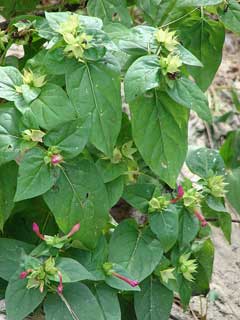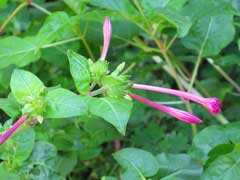 |
|
http://www.hear.org/starr/ |
 |
| http://commons.wikimedia.org/wiki/User:GTBacchus |
Translate this page:
Summary
Bloom Color: Pink, Red, White, Yellow. Main Bloom Time: Early fall, Late summer, Mid summer. Form: Upright or erect.
Physical Characteristics

 Mirabilis jalapa is a PERENNIAL growing to 0.6 m (2ft) by 0.5 m (1ft 8in) at a fast rate.
Mirabilis jalapa is a PERENNIAL growing to 0.6 m (2ft) by 0.5 m (1ft 8in) at a fast rate.
See above for USDA hardiness. It is hardy to UK zone 8 and is frost tender. It is in flower from July to October, and the seeds ripen from August to October. The species is hermaphrodite (has both male and female organs) and is pollinated by Insects.
Suitable for: light (sandy), medium (loamy) and heavy (clay) soils and prefers well-drained soil. Suitable pH: mildly acid, neutral and basic (mildly alkaline) soils. It can grow in semi-shade (light woodland) or no shade. It prefers moist soil.
UK Hardiness Map
US Hardiness Map
Synonyms
Plant Habitats
Cultivated Beds;
Edible Uses
Edible Parts: Leaves
Edible Uses: Colouring Condiment
Tender young leaves - cooked as a vegetable[105, 183, 272]. An emergency food, only eaten when all else fails[177]. An edible crimson dye is obtained from the flowers[46, 61, 105, 177]. It is used for colouring cakes and jellies[183]. The seed is crushed and used as a pepper substitute[105, 177, 183].
References More on Edible Uses
Medicinal Uses
Plants For A Future can not take any responsibility for any adverse effects from the use of plants. Always seek advice from a professional before using a plant medicinally.
Diuretic Purgative Vulnerary
The root is aphrodisiac, diuretic and purgative. It is used in the treatment of dropsy[46, 61, 154, 218, 240]. A paste of the root is applied as a poultice to treat scabies and muscular swellings[272]. The juice of the root is used in the treatment of diarrhoea, indigestion and fevers[272]. The powdered root, mixed with corn flour (Zea mays) is baked and used in the treatment of menstrual disorders[272]. The leaves are diuretic[272]. They are used to reduce inflammation[240]. A decoction of them is used to treat abscesses[218]. The leaf juice is used to treat wounds[218].
References More on Medicinal Uses
The Bookshop: Edible Plant Books
Our Latest books on Perennial Plants For Food Forests and Permaculture Gardens in paperback or digital formats.

Edible Tropical Plants
Food Forest Plants for Hotter Conditions: 250+ Plants For Tropical Food Forests & Permaculture Gardens.
More

Edible Temperate Plants
Plants for Your Food Forest: 500 Plants for Temperate Food Forests & Permaculture Gardens.
More

More Books
PFAF have eight books available in paperback and digital formats. Browse the shop for more information.
Shop Now
Other Uses
References More on Other Uses
Cultivation details
Landscape Uses:Border, Container, Specimen. Succeeds in almost any ordinary garden soil[1]. Prefers a fertile well-drained soil in full sun or part day shade[200]. This species is not very hardy in Britain. The top growth is cut back by frost but the tuber survives the winter outdoors if the temperature does not fall much below -5°c, a good mulch would be beneficial[200]. Tubers can be lifted and stored over winter in a cool frost free place in the same way that dahlia tubers are stored[1, 200]. The marvel of Peru is usually grown as a half-hardy annual in temperate zones, it flowers freely in its first year[200]. Plants also self-sow freely in warmer areas (these seedlings can be easily transplanted) and they can become a weed in such situations due to their deep rooting habit[200]. This species was cultivated as a medicinal plant by the Aztecs prior to the Spanish conqust[274]. The flowers are sweetly scented and do not open until the afternoon[233]. The young growth is particularly susceptible to aphis infestation[200]. Members of this genus are rarely if ever troubled by browsing deer[233]. Special Features:Attracts birds, Not North American native, Naturalizing, Fragrant flowers.
References Carbon Farming Information and Carbon Sequestration Information
Temperature Converter
Type a value in the Celsius field to convert the value to Fahrenheit:
Fahrenheit:
The PFAF Bookshop
Plants For A Future have a number of books available in paperback and digital form. Book titles include Edible Plants, Edible Perennials, Edible Trees,Edible Shrubs, Woodland Gardening, and Temperate Food Forest Plants. Our new book is Food Forest Plants For Hotter Conditions (Tropical and Sub-Tropical).
Shop Now
Plant Propagation
Seed - sow spring in a greenhouse. When they are large enough to handle, prick the seedlings out into individual pots and plant them out in early summer, after the last expected frosts. The seed remains viable for several years[196]. Division in spring as the plant comes into growth[200].
Other Names
If available other names are mentioned here
Native Range
Coming Soon
Weed Potential
Right plant wrong place. We are currently updating this section.
Please note that a plant may be invasive in one area but may not in your area so it's worth checking.
Conservation Status
IUCN Red List of Threatened Plants Status :

Growth: S = slow M = medium F = fast. Soil: L = light (sandy) M = medium H = heavy (clay). pH: A = acid N = neutral B = basic (alkaline). Shade: F = full shade S = semi-shade N = no shade. Moisture: D = dry M = Moist We = wet Wa = water.
Now available:
Food Forest Plants for Mediterranean Conditions
350+ Perennial Plants For Mediterranean and Drier Food Forests and Permaculture Gardens.
[Paperback and eBook]
This is the third in Plants For A Future's series of plant guides for food forests tailored to
specific climate zones. Following volumes on temperate and tropical ecosystems, this book focuses
on species suited to Mediterranean conditions—regions with hot, dry summers and cool, wet winters,
often facing the added challenge of climate change.
Read More
Expert comment
Author
L.
Botanical References
200
Links / References
For a list of references used on this page please go here
Readers comment